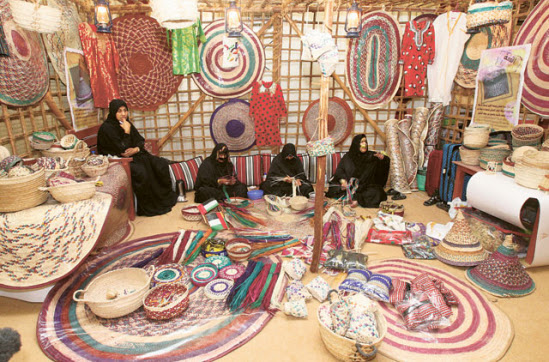 |
| Traditional Emirati Arts and Crafts |
The UAE boasts a rich cultural heritage, with its arts and crafts reflecting the nation's history, traditions, and creativity. Traditional Emirati arts and crafts encompass a wide range of forms, from intricate weaving to delicate pottery and mesmerizing calligraphy. Let's embark on a captivating journey through these treasures, exploring their origins, cultural significance, and the skills required to create them.
The Beauty of Traditional Emirati Arts and Crafts
Traditional Emirati arts and crafts encompass a myriad of forms, each with its unique charm and significance. These exquisite creations offer insights into Emirati culture, heritage, and values. Here are some of the most captivating facets:
Al-Sadu Weaving: A Time-Honored Tradition
Al-Sadu weaving is a centuries-old craft that involves creating intricate patterns and designs on textiles. These textiles are often used to make tents, rugs, and cushions. The art of Al-Sadu weaving is passed down through generations, with each piece telling a story of Emirati life.
Pottery: Craftsmanship in Clay
Emirati pottery is celebrated for its elegant forms and intricate decorations. Local clay is skillfully shaped into various vessels, ranging from ornate bowls to decorative plates. The pottery often features geometric patterns and symbols that hold cultural significance.
Calligraphy: The Art of Expression
Arabic calligraphy is a highly regarded form of artistic expression in the UAE. Talented calligraphers create stunning compositions using Arabic script. These pieces often feature verses from the Quran or inspirational quotes, highlighting the significance of Arabic calligraphy in Emirati culture.
Jewelry-Making: Adorning with Elegance
Traditional Emirati jewelry is known for its exquisite craftsmanship. Skilled artisans meticulously craft jewelry pieces, incorporating precious metals and gemstones. The jewelry often features intricate filigree work and reflects the region's aesthetic sensibilities.
Traditional Emirati Arts and Crafts: A Cultural Heritage
Traditional Emirati arts and crafts are deeply intertwined with the nation's cultural heritage. They offer a glimpse into Emirati identity, values, and way of life. Here's why these crafts are considered a cultural treasure:
Preserving Tradition: These crafts are passed down from one generation to another, ensuring that Emirati traditions and skills remain alive and thriving.
Cultural Significance: Traditional Emirati arts and crafts often feature symbols and motifs that hold cultural and religious significance. They serve as a means of preserving and transmitting these symbols.
Community Bonding: Craftsmanship is often a communal endeavor, fostering a sense of togetherness and shared identity among Emirati communities.
Economic Importance: Traditional crafts contribute to the local economy by providing livelihoods for artisans and contributing to the tourism industry.
FAQs about Traditional Emirati Arts and Crafts
Q: What materials are commonly used in Emirati pottery?
A: Emirati pottery is typically crafted using locally sourced clay, which is known for its high quality and versatility.
Q: Are there any specific patterns or symbols used in Al-Sadu weaving?
A: Yes, Al-Sadu weaving often features geometric patterns, camel motifs, and symbols inspired by the desert landscape.
Q: How long does it take to become proficient in Arabic calligraphy?
A: Becoming proficient in Arabic calligraphy can take several years of dedicated practice and study under a skilled calligrapher.
Q: Where can I purchase authentic Emirati jewelry?
A: Authentic Emirati jewelry can be found in traditional markets (souks) across the UAE, particularly in Dubai and Abu Dhabi.
Q: Are there any workshops or classes for learning traditional Emirati crafts?
A: Yes, many cultural centers and organizations in the UAE offer workshops and classes where you can learn traditional Emirati crafts.
Q: What role do traditional crafts play in Emirati festivals and celebrations?
A: Traditional crafts often play a central role in Emirati festivals and celebrations, with artisans showcasing their creations and offering them as gifts.
Conclusion
Traditional Emirati arts and crafts are not just beautiful creations; they are the threads that connect the past, present, and future of the UAE. Through the art of Al-Sadu weaving, the elegance of Emirati pottery, the grace of Arabic calligraphy, and the allure of traditional jewelry, these crafts embody the essence of Emirati culture and heritage. Explore them, appreciate them, and be inspired by the timeless beauty of Traditional Emirati arts and crafts.